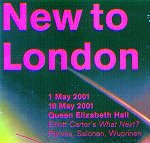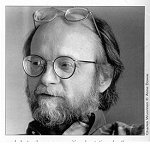
For their two New to London concerts in May, the London Sinfonietta's emphasis was on American music. Eliot Carter's short opera What next? deals ostensibly with confusion after a catastrophe, a multiple pile-up on the roads, maybe, in which the protagonists are surprised find themselves, perhaps, dead, with their plans for the day seriously interrupted? One of those inscrutable, symbolic texts with little sure to hold on to, and the words mostly inaudible anyway with the singers placed at the back of the stage behind the orchestra, and really needing to have been discreetly miked. A small boy hankered for a big Mac, others were on their way to a wedding, and so on. Coruscating instrumentation, with all the skill mustered by complexitist Elliott Carter over his ninety years, was its chief pleasure, but it is unlikely to enter the repertoire. A well balanced CD with the words supplied might give a better impression.
I could make nothing of the young Dutch composer Richard Rijnvos' Block Beuys - Raum 2, but I have comparable difficulty with the ubiquitous installations of Joseph Beuys, the conceptual artist one is likely to encounter in contemporary art collections. Esa-Pekka Salonen's Mania, composed for cellist Anssi Kartunen, has the virtuoso solo line spotlit, but also at times integrated within a typical Sinfonietta line-up of instrumental soloists. Its vivacity and imagination made a more favourable impression at QEH than previously in the huge auditorium at Porvoo - tuneful and even seeming to be tonally based at times, this conductor-composer brings his practical knowledge of the orchestra to his own writing and has a welcome sense of fun.

Cyclops (2000) for 20 players by Charles Wuorinen owed its
world premiere in this series to the desire of Risk Publications to
mark the tenth anniversary of their magazine Risk with an enduring
commission of 'a new work of art or music', and the London Sinfonietta was
included in their enquiries - Oliver Knussen suggested Wuorinen as a suitable
beneficiary, and this chimed in with the interests of Peter Field, Risk Waters'
Chairman, who had loved what he had heard on three Wuorinen CDs. London
Sinfonietta (which had been taken aback by such a generous approach out of
the blue!) gladly accepted this commission for a work which would not be
heard until the 21st Century by a composer who, for Field, 'seemed to epitomise
modern music'.
I knew Wuorinen's name but his music had not registered with me before hearing this major work, about 25 mins. Prolific and unwavering in his 'maximalist' affiliation, he has not allowed himself to be influenced by the easier and fashionable minimalist persuasion. The composer envisages Cyclops (2000) as proceeding in fits and starts 'rather like the stock market' towards a dense environment, 'an old-fashioned narrative form given contemporary clothing'. Each player has his turn in the spotlight in solos and duetting pairs, and I found the piece compelling in its energy and well heard sonorities, and the most rewarding of those in the two concerts; of other critics, one commended its impeccable technique and the performance, but found that 'it failed to say anything fresh' (The Times).
Taking a leaf out of Peter Field's experience, I have greatly appreciated Seen&Heard's opportunity to explore Wuorinen a little further by sampling some of his many CDs kindly supplied for our consideration, a good illustration of the indissoluble interrelationship of live and recorded listening for coming to grips with the diversity of contemporary musics. Varese, the later Stravinsky, Wolpe, Carter & Babbitt have been amongst his influences, and he has a penchant for virtuosity. Works for violin (Benjamin Hudson) and piano (Garrick Ohlsson) on Bridge BCD 9008 give a good conspectus, including The Blue Bamboula (after Gottschalk) a brilliant West Indies-based dance (with an allusion to Tchaikovsky's 1st Piano Concerto) and Spinoff (violin, bass and conga drums) an attractive reminder of The Soldier's Tale. These are suitably recorded bright and close in a dry acoustic. Stefan Wolpe, who adopted the overall philosophy of the twelve-tone method in a completely original way) was an important influence upon Wuorinen and Feldman, two very different composers coupled on a more sympathetically recorded recital of music from the 1980s, superlatively played by Alan Feinberg (Koch International Classics 3-7308-2), with Wuorinen's 3rd Sonata, Bagatelle and Capriccio contrasted with Feldman's last, and short at 22 mins, piano piece Palais de Mari. Wuorinen's substantial Bagatelle (a world away from Beethoven's) can be heard in context with music by Stefan Wolpe, Oliver Knussen and some of the century's 'establishment composers' on a fine recital by Peter Serkin (Koch International Classics KIC-7450).
Peter Grahame Woolf
 Return to:
Return to: